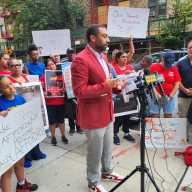Roughly 17,800 square miles of open space in America have been lost to development between 2002 and 2017, climate scientists and researchers report. Over that same 15-year span, New York state has lost 344 square miles of open land, as accommodating for population spikes over the past decades has come at the expense of natural land.
Scientists and climatologists warn that without a change in America’s development practices — which is aggressively accounting for large spikes in the U.S. population — by Earth Day 2025, the U.S. could lose the equivalent of 17 Washington, D.C.-sized parcels of open space.
“Our leaders at the local, state, and federal level will have to make hard choices in the years ahead,” Leon Kolankiewicz, an environmental planner and co-author of the study From Sea to Shining Sprawling Sea: Quantifying the Loss of Open Space in America told the Bronx Times. “We can stay on our current track — and continue to lose the equivalent of 17 Washington, D.C.’s worth of open space every year. Or we can recognize that our growing population is causing the loss of open space — and do something about it.”
The report uses U.S. Department of Agriculture data from every state in the Lower 48 to detail how much land has been converted from forests and fields into strip malls, subdivisions and other development. Since 1982, a quinquennial, or five-year analysis has been conducted for non-federal land change, seeing where rural land has been transformed into pavement or structures that strip the land of its natural characteristics.
Nationally, a new study tallies a total of at least 68,000 square miles of vanished open spaces over that same time, with the heaviest losses in faster-growing Sun Belt states such as California, Texas and Florida.
The study also identifies what drove that development on a county-by-county basis, with the No. 1 contributor to the “alarming” disappearance of open space being population growth. The U.S. population has grown by nearly 50 million over the last two decades.
“Our nation is losing open space at an alarming rate,” said Kolankiewicz. “Our analysis — which includes searchable county-level data — shows that every state has lost rural land this century.”
As Kolankiewicz details, that level of growth imperils the nation’s biodiversity and wildlife, and could worsen air and water pollution. Roughly 79% of people surveyed for the report believe that the destruction of farmland and natural habitat because of urban sprawl in the United States is a problem, with 44% viewing it as a “major problem”and 35% “somewhat of a problem.”
Urban sprawl is defined as “the spreading of urban developments on undeveloped land near a city.” Urban sprawl has been described as the unrestricted growth in many urban areas of housing, commercial development and roads over large expanses of land.
“At both the state level and the national level there is a broad correlation between population size and sprawl: generally, the larger a city, county, or state’s population, the larger the land area it will sprawl across,” Kolankiewicz said.
A late 2022 study will look at the effects of urban sprawl in the New York metropolitan region. New York is a special case, virtually in a category by itself, because of the distortion, experts say, that is caused by the extreme population density in high-rise and skyscraper-dense New York City.
The study suggests populous and more densely-populated states like California and New York suffered more from the highly restrictive government response to the pandemic than lower-density states like Montana and South Dakota. As long as the population is still growing, the land area taken up by American towns and cities will continue to grow.
Higher taxation of vehicles and investment in greener public transport systems could combat the harmful environmental and social effects of urban sprawl, says the Organization for Economic Cooperation and Development.
Reach Robbie Sequeira at rsequeira@schnepsmedia.com or (718) 260-4599. For more coverage, follow us on Twitter, Facebook and Instagram @bronxtimes.























